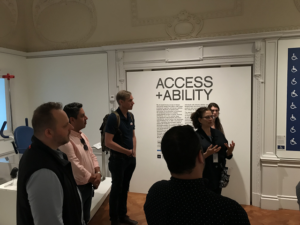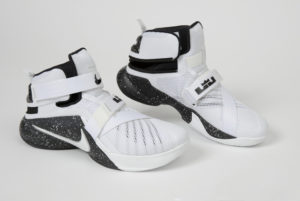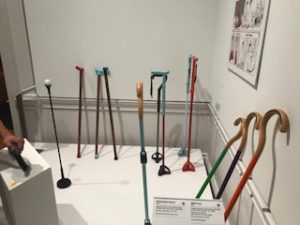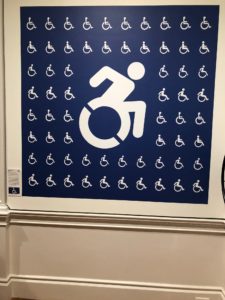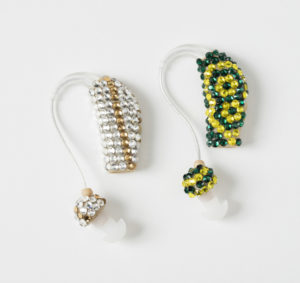- July 10, 2018
- 0 Comments
- In Accessible Design and Construction
- By Peter Stratton
SWA’s Accessibility Consulting Team recently had the opportunity to tour the Cooper Hewitt Museum’s Access+Ability exhibition, where the theme of inclusive and accessible design is displayed and celebrated. The exhibit narrates a history of design with disabilities in mind, focusing on the “surge of design with and by people with a wide range of physical, cognitive, and sensory abilities.” As we moved through the exhibit, I found it fascinating to see how products or designs that were initially intended to address a need brought on by a disability (like email or text messaging) have now been adapted into everyday modern conveniences. It’s interesting to bring this idea back to our work as accessibility consultants – often, if designers are willing to incorporate inclusive or universal design principles, it is possible for accessible features to blend seamlessly into the overall design intent, providing an environment that can be easily and equally used by everyone, with or without a disability.
Here are some thoughts on the exhibition from other members of our Accessibility Consulting Team…
“I really liked the portion of the exhibit that showcased wearables, specifically the jacket for people with autism and the slip-on sneakers. Both products were fashionable pieces that answered specific physical needs and conditions. Each product was the result of great engineering while staying stylish and staying away from a clunky and clinical look. These products are very inclusive and can be used by all members of a family without making it feel like a product to be used exclusively by people with disabilities.”
–Harold Bravo, Accessibility Consulting Director
“I was introduced to SWA’s Accessibility Team and the world of accessible design through the visit to the Cooper Hewitt Museum. I was very moved by projects like a wheelchair for people with disabilities in developing countries and was reminded that simple innovations can make a huge change in a person’s life. People are intrinsically connected to their environments, and having a better understanding of how people with disabilities interact with their surroundings means knowing more about how to design the most useful objects and equipment possible. The exhibition was interactive and well designed and I highly benefited from the tour guide further explaining each of the creations.”
–Claire Daugeard, Accessibility Consulting Services Intern

AdhereTech Smart Pill Bottle, Designed by Mike Morena, Manufactured by AdhereTech; Image by Cooper Hewitt Museum
“It was really interesting to see the personal side of accessible design – innovations in day-to-day life that can make someone’s daily activities a little bit easier. For some products or features exhibited, it was something small like a pill bottle with a sensor to alert you when the user has forgotten to take his/her medication, for others, it was something on a large scale like an app to crowdsource information about the accessibility of public spaces worldwide.”
–Kayla Doshier, Accessibility Specialist
“One of the things I found most interesting was walking in and seeing a familiar product in a museum. The Adhere Tech “smart” pill bottle was given to my father to remind him to take his chemo meds at specific times. A light at the bottom of the bottle glows blue until he opens the bottle and removes the correct number of pills. If he goes too long without taking his pills the bottle starts to chime and if he still doesn’t take the medicine, then the bottle calls his cell phone to give him a reminder. It is a great feature for elderly people who have to take medicines and is especially useful when dealing with a non-daily medicine.”
–David A. Mike, Accessibility Specialist
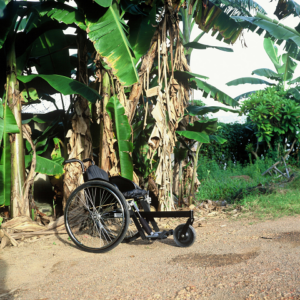
Motivation Rough Terrain, Designed by Motivation, Manufactured by Merits; Image by Cooper Hewitt Museum
“I think one of the things I found most interesting about the experience has to do with the integration of technology and modern processes – the idea of accessible features does not have to be so sterile and commercial as we sometimes associate with it (e.g., the old school metal wheelchair or walking cane). New products, materials, and ideas all lead to a more accessible, and accepting, world.”
–Tim Perry, Senior Accessibility Consultant
“My main takeaway from the Cooper Hewitt Exhibit really boils down to the fact that all of the items that we looked at, while utile in terms of accessibility, were also quite beautiful. At the end of the day it’s pretty hard to put a stigma on something that is pleasing to the eye, which I’m sure is partly what the designers of these “tools” had in mind – the utility to those who would be using the products, and the vanity of those that would be looking at them using the products.”
–Carlos Sevillano, Accessibility Specialist
“One of the things that I found most interesting was the display of the new dynamic symbol of accessibility that replaces the conventional International Symbol of Accessibility (ISA) under the New York City and Connecticut building codes. The new dynamic symbol is certainly a move in the right direction, but for those of us who work in the world of accessibility compliance, the new symbol is causing some confusion. Regardless of a code that requires use of the new active symbol, the laws that apply to most of the same projects covered by the code require use of the conventional ISA. So if the code requires the new active symbol to be used but the law requires the conventional and static ISA to be used, then what do we do? In the case of these two symbols, guidance from the US Access Board is clear, the conventional symbol must be used even if the applicable code requires use of the active symbol. Seem counterintuitive? You decide. According to the US Access Board, the active symbol would comply with the Americans with Disabilities Act if it meets the provision for ‘equivalent facilitation,’ which means that it provides ‘substantially equivalent or greater accessibility and usability.’ If there is ever a legal challenge on the use of the active symbol, then the burden of proving equivalent facilitation ‘rests with the covered entity in the event of a legal challenge.’
Although the museum’s display of the art piece depicting the progression of the static ISA to an updated and more appropriate active symbol is nice to look at – there’s so much more than meets the eye!”
–Peter Stratton, Senior Vice President, Managing Director, Accessibility Services
“For me, one of the biggest takeaways from the Access+Ability exhibition is that it is possible to design sleek, creative, aesthetically-pleasing, and functional products that enhance accessibility and improve people’s lives. One of the items that I found most interesting was an earpiece that was designed as a piece of jewelry. Such a product shows us that it is possible to practice good design to create functional items that enhance accessibility and improve people’s lives.”
— Samuel Tellechea, Accessibility Consultant
The Cooper Hewitt’s Access+Ability exhibition is open through September 3, 2018 – we highly recommend checking it out!
Written by Theresa D’Andrea, Accessibility Consultant

